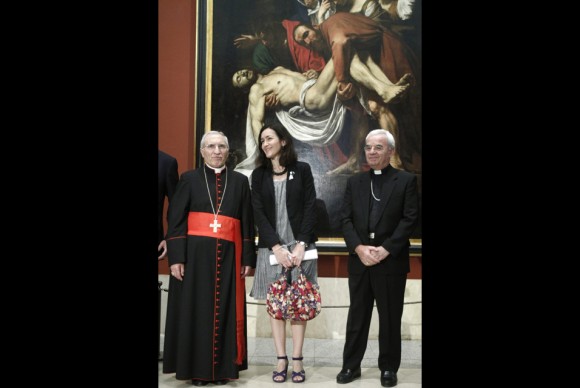Prado Displays Caravaggio’s Entombment of Christ, on Loan from the Vatican Museums
MADRID.- To coincide with the celebration of World Youth Day and with Pope Benedict XVI’s visit to Madrid, the Museo del Prado will be displaying. The Entombment of Christ, a major masterpiece by Caravaggio loaned from the Vatican Museums. For the first time in Spain, this monumental canvas will be exhibited for two months at the Prado thanks to sponsorship from the Fundación Amigos del Museo del Prado and as part of the “Invited Work” exhibition programme. This exceptional loan is also part of the thematic tour entitled “The Word made Image. Paintings of Christ in the Museo del Prado” that the Museum has devised in conjunction with World Youth Day and which includes a further thirteen paintings.

- Spanish prelate of the Roman Catholic Church, Antonio Maria Rouco Varela (L-R), Spanish Culture Minister, Angeles Gonzalez Sinde, and Nuncio Renzo Fratini, pose in front of Italian artist Michelangelo Merisi da Caravaggio’s (1571-1610) ‘The Entombment of Christ’ (1602-1603) at the Prado Museum in Madrid, Spain, 21 July 2011. Caravaggio’s painting has traveled from the Vatican’s Museum in order to be shown at the Spanish Museum for two months. EPA/ESPINOSA.
As part of its “Invited Work” exhibition programme and for a period of two months (21 July to 18 September 2011), the Museo del Prado is offering visitors the exceptional opportunity to see The Entombment of Christ (1602-1604) by Caravaggio, a work that has never previously travelled to Spain. One of the revolutionary Italian painter’s most important works, it is normally housed in the Vatican Museums. Its loan constitutes a particularly special contribution by Pope Benedict XVI to the city that is hosting World Youth Day this year. As a result of this loan, the Museo del Prado has the privilege of offering visitors the chance to see this remarkable work that received the unanimous approval of critics when it was first created and which was not the subject of any criticisms, as was generally the case on the presentation of work by the brilliant but controversial Michelangelo Merisi, known as Caravaggio.
In addition, and also in conjunction with World Youth Day and the Pope’s visit to Madrid, The Entombment of Christ will form part of the thematic tour entitled “The Word made Image. Paintings of Christ in the Museo del Prado” that the Museum has devised (in collaboration with World Youth Day 2011) around a group of fourteen selected masterpieces from its collection that depict different episodes from the life of Christ.
The Entombment of Christ
The year 1604 was of particular importance in the life of Michelangelo Merisi, known as Caravaggio (Milan, September 1571 – Porto Ercole, July 1610). In addition to a lengthy series of legal problems arising from his irascible, argumentative character, it is known that on 1 September of that year the artist presented The Entombment of Christ, a work very probably commissioned by Girolamo Vittrice for the main altar of his family chapel in the Roman church of Santa Maria in Vallicella, also known as the Chiesa Nuova, which belonged to the Oratorians of Saint Philip Neri. On its public presentation the work was greeted with heartfelt admiration by the artist’s contemporary biographers and there was no sign of the negative opinions that so often marked the reception of Caravaggio’s works.
In The Entombment of Christ, Caravaggio arranged the figures in a compact composition consisting of a group outlined against a dark background, structured through a diagonal line that starts in the lower left corner and runs across to the other side of the canvas. In the foreground on the right are Nicodemus, who turns his face to the viewer, and Saint John the Evangelist, both of whom bear Christ’s body. Christ’s hand brushes the slab on which he will be washed, anointed and perfumed in a gesture that probably refers to him as the corner-stone and foundation of the Church. Behind the two men are Christ’s mother Mary in a contained pose, Mary Magdalen, who dries her tears with a white handkerchief, and Mary of Cleophas, who raises her arms to the sky in a gesture of desolate grief. Seen together, the three women constitute different, complementary expressions of suffering. With this work Caravaggio created a strikingly monumental and dramatic image for the altar piece and one that is emphasised by the pronounced chiaroscuro in which the scene is enveloped.
Different iconographical sources have been proposed for the painting and it is clear that Caravaggio derived the body of Christ from Michelangelo’s Pietà, a work to which he frequently made reference in his own creations. In addition, it has been suggested on various occasions that the manner of presenting the lifeless body of Christ is based on classical reliefs. Caravaggio, however, reworked these sources and influences to create a work that is completely new from an iconographical and spiritual viewpoint.
The painting was looted in 1797 by the Napoleonic troops with the intention of adding it to the collection of the Musée Napoléon in Paris. It was returned to Rome in 1817, at which point it entered the Vatican Museum.
Related posts:
- The Prado Museum Announces Presentation of Its Collection in Australia
- The Hermitage and the Prado Announce Exchange of Important Selection of Works
- Spanish King Juan Carlos and Queen Sofia Open “The Prado in the Hermitage” Exhibition
- Museo del Prado Publishes First Multi-Interactive, Online Video Relating to Art
- The Museo del Prado extending the exhibition “A Passion for Renoir”
